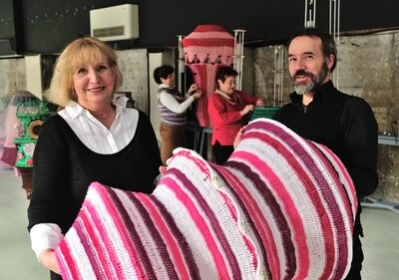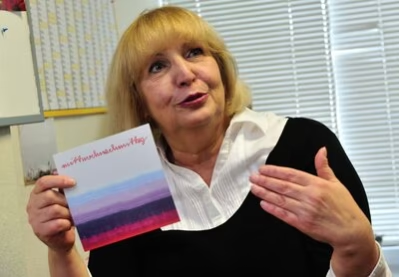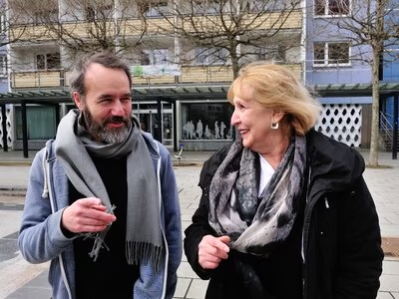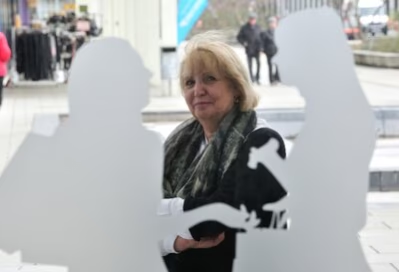Where time has a different pace
Birgit Leibner & Ingolf Watzlaw
The former "Charts" music centre on the Rosenhof is being painted and swept. Unusual frames and colourful fabric elements fill the space. It's not a new shop that's moving in here, but a special exhibition that will soon be on show. Two elderly ladies are decorating a kind of floor lamp covered with knitted fabric. Birgit Leibner from Bürgerhaus City is standing in the middle of it, discussing with Ingolf Watzlaw what they still have to do before next Friday, 19 February. The space will then be transformed by 20 knitted light objects with an integrated sound installation and a video work that corresponds to the installation, developed with women from a knitting and crochet course that takes place on Wednesday afternoons. We spoke to Birgit Leibner and Ingolf Watzlaw about this unusual art project.
What happens on Wednesday afternoons at Bürgerhaus City?
Birgit Leibner: People knit, make lace or sew. A knitting group of up to 20 women aged between 40 and 90 meets here.
Do all the women here come from the local area?
Birgit Leibner: Many, but not all. Half of them come directly from the city centre. Some used to live in the city centre but have now moved elsewhere, but still come to our events. Yes, the whole city centre actually meets here now. A casual get-together has developed into a course. This knitting group was already involved in the balcony ballet, so it made sense to develop the idea further.
Ingolf Watzlaw: The women were so committed to the balcony ballet. At the closing ceremony, we decided to take up the idea again and create our own project.
The balcony ballet was the first art event of its kind to take place at the Rosenhof in 2013. Back then, Gabi Reinhardt, a theatre teacher from Chemnitz, transformed the striking high-rise building into a large theatre stage together with the building community. Ingolf Watzlaw was responsible for the stage design for the balcony ballet. "The women had crocheted an incredible number of individual pieces," says Watzlaw. "We came up with a scarf for the balcony ballet. It stretched almost from top to bottom. But there was still so much of the handicrafts left over that we thought about what else we could make from it. That's how the first lamps were created - the archetype of what we will see at 'mittwochnachmittag'."
How did you tackle this art project?
Ingolf Watzlaw: We wanted to look at two aspects. On the one hand, it was about the community that is created when people meet regularly in these groups. And secondly, the aspect of time, as we see craftsmanship as a counter-movement to social acceleration. It was about two questions: What experiences of time characterise our everyday lives? And how do we want to live and work together? In the world of work, I see many processes that are anything but democratic. The question is what this does to us and what a democratisation of the world of work would look like.
Birgit Leibner: Many people really do see these rounds as a way of levelling out. Some of the participants work. They always try to come anyway. That's the moment when they let themselves go. The time is all theirs. Time moves at a different pace.
Ingolf Watzlaw: We organised two workshops on the two topics of society and time. The women did so much knitting. We drew. We have a choreographer with us who wants to show the physical aspect. We also received support from the university and discussed theoretical questions. And while we were meeting to discuss the topics, we kept on knitting.
Birgit Leibner: (laughs) Yes. Even during the lecture from the Industrial Museum, which the women followed attentively, they were knitting on the side.
Ingolf Watzlaw: Knitting helped us to completely rethink the aspect of time.
How did the art objects ultimately emerge from these workshops?
Ingolf Watzlaw: We developed these art objects together. I designed these lamp-like shapes as a guideline. However, the women were completely free in their design. We also knew that the objects should be illuminated and reflect the personalities of the women. We then made interviews that could be played in the individual objects via loudspeaker modules. We also recorded the production process and the thoughts of the participants in a video installation.
Birgit Leibner: We also had wonderful co-operation partners, the Berufsförderungs-Network e. V., who made the wooden frames. A lot of people really helped us and just joined in. Everyone, especially the 20 women, stayed on this topic for over a year.
What is special about such a collaboration?
Birgit Leibner: It was remarkable how the participants worked on this topic and in some cases surpassed themselves. We needed texts to describe the objects. There were so many thoughts and feelings, the motivations are wonderfully comprehensible. And the women developed great self-confidence and were absorbed in their work.
Ingolf Watzlaw: The question was always whether we should intervene or dictate or simply let the women do it. We let them do it because it was so exciting to see how the whole thing grew.
Birgit Leibner: The objects were then constantly developed further. The lighting was added, then they moved. The sound was added. It was like a self-runner.
The exhibition will take place in a shop that has been empty for some time in the Rosenhof, just a few metres from your Bürgerhaus City. Why there?
Ingolf Watzlaw: We looked at a lot of exhibition venues. This space, the former music store "Charts", was also one of them at the very beginning. But given its condition, we thought we'd better leave it alone. (laughs)
Birgit Leibner: We needed a large, high-ceilinged room. But with the museums in the city that have such rooms, it would have been difficult to open the exhibition free of charge, for example.
Ingof Watzlaw:law: We went to the shop two or three times and then at some point we thought: maybe it will work after all. After many hours of work, we are now in a position where we can say: yes, it will work.
But the fact that the project itself can now be shown again in the Rosenhof is a great advantage.
Birgit Leibner: Definitely. It's important for the Rosenhof. The flats here are very well let, but unfortunately the shops are not. We are so close to the town hall, but the potential is not being utilised. It's such a beautiful area. Totally suitable for outdoor art and culture. Suitable for families. It's a place to relax and unwind.
What are you doing to revitalise the Rosenhof?
Birgit Leibner: We are an association that is very broadly based and takes on many tasks, sometimes too many. We are a socio-cultural centre. We have a lot of educational programmes and a lot of people come here. Unfortunately, we barely have enough space here. We offer everyday support for older people who live here, we organise guest flats, offer English and German courses and computer courses. There are lots of creative activities and we also run the transparent workshops project. I would really like to have more space for the many creative ideas and, above all, the encounters between Germans and non-Germans.
How many people are involved in your organisation?
Birgit Leibner: There are around 60 people, 22 course leaders alone.
What is special about your work?
Birgit Leibner: It's the contact with people and seeing so many people getting involved. Working with volunteers is not always easy because they also need guidance and want to be appreciated. Many people do an incredibly good job here - without receiving anything in return. You should actually say more often: It's great that you're doing this. I also do it here because I think it's important to do something for integration. And it really is about doing, not just making appeals or talking.
Is the Rosenhof also your favourite place?
Birgit Leibner: I have a special relationship with the Rosenhof. We got our first flat here when I was nine. We later moved to other neighbourhoods in Chemnitz. And when my children were out of the house, I moved back to Rosenhof. I'm quickly at the museum and the theatre here. There's always something happening. But we still live here in a quiet neighbourhood. Oh, and there are actually many beautiful places in Chemnitz, for example the Schloßberg and the Schloßteich.
Ingolf Watzlaw: I actually live in Berlin, I was in the city for a long time for the balcony ballet and now I'm back again. I've seen a lot of the city centre. I quickly became fond of the city. There are conspicuously empty areas, but also very pretty corners, like the Kaßberg. What kept going through my mind during my walks was that there are many places here that could or could be re-appropriated. Maybe there were places like this in Berlin 15 years ago and most of them are now occupied. You can still let your imagination run wild here.
Do you have to encourage the people of Chemnitz?
Birgit Leibner: The people of Chemnitz have far too poor an image of their city. But the city can only change with the citizens and through the citizens. Visitors often appreciate more what they have in the city. This compact city, where you can get from A to B quickly, which has a lot to offer culturally. And it's absolutely not true that there's nothing going on in Chemnitz. I would really like to see a more cheerful Chemnitz. Instead of claiming that we are the oldest city, we should say: look, it's good to grow old here. And I see so many young people and families here that I have no fears for the future. And if we accept that not everyone in this city has to be Saxon, then a lot is still possible.






